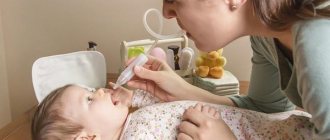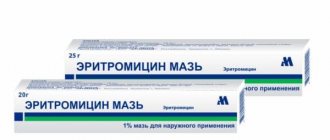Causes
Nasal congestion in newborns is caused by imperfections in the anatomical structures and functioning mechanisms of the upper respiratory tract. Single-celled glands of the mucous membrane periodically show hyperactivity, producing excess secretions. Due to the narrowness of the nasal canals, mucus is subject to stagnation and thickening. This is why babies often have a stuffy nose. Physiological swelling of the nasopharynx is also observed during teething from 6 months of age.
At the same time, pathological factors can become the cause of hypersecretion and swelling of the soft tissues of the nose:
- viral and bacterial infections;
- allergic reactions;
- injuries or congenital defects of the nose (deviated septum, choanal atresia);
- polyps in the paranasal sinuses;
- hypertrophy of the nasopharyngeal tonsil (adenoids).
Symptoms
Obstruction of the nasal canals negatively affects the quality of life of the baby - the sucking reflex is disrupted, dyspepsia occurs, tearfulness and sleep problems are noted. Let's consider the main forms of nasal breathing disorder in an infant and the accompanying symptoms.
Physiological rhinitis
Until about 3 months of age, one of the main causes of nasal congestion in a baby is a physiological runny nose. Its symptoms:
- Moderate amount of clear secretion in the nasal canals.
- The so-called “grunting” nasal breathing.
- No fever or intoxication.
- There are no signs of conjunctivitis, hyperemia or swelling of the nasopharynx.
Problems with nasal breathing in the morning are often caused by insufficient air humidity in the room. To optimize the microclimate, humidifying devices are used or wet towels are placed near the child's seat. Normalization of breathing during the day indicates that the main problem was dry air.
If a baby's nose gets stuffy at night, then, as a rule, this indicates hypersecretion of the nasal mucosa. In addition to difficulty with nasal breathing, the exudate, going down the respiratory tract, provokes a dry cough.
Obstruction of the nasal passages makes breastfeeding difficult, so the baby refuses to eat, sleeps poorly and cries often. The absence of nasal breathing in an infant for a week is assessed as constant nasal congestion and requires specialist intervention.
Allergic reactions
Due to the immaturity of the immune system, allergic manifestations are much more common in infants than in adults. With allergic edema of the upper respiratory tract, an infant has a stuffy nose, copious discharge of clear mucus, dry cough, lacrimation, and conjunctival hyperemia.
Allergens most often include household microscopic mites, plant pollen, pet hair, household chemicals, and children's hygiene items.
Infection
Due to the lack of adaptive immunity, the infant is especially susceptible to respiratory diseases of a viral and bacterial nature. ARVI causes swelling and hyperemia of the nasopharynx, the nasal canals are filled with clear or whitish mucus, body temperature is 37.3-38⁰C, the baby often grunts through his nose, and a cough is often noted. Thickening of the mucus and the appearance of pus in it indicates a bacterial infection, the temperature rises above 38°C, and signs of intoxication are evident.
Adenoids and polyps
Hypertrophy of the nasopharyngeal tonsil occurs after suffering from colds, measles, sore throat, scarlet fever. An enlarged tonsil (adenoids) can cause nasal congestion in a baby from 2 months. Associated symptoms in this case will be decreased hearing, profuse nasal discharge, sleep disturbance, and tearfulness. The lack of competent treatment at the first signs of adenoiditis is fraught with chronic nasal congestion in the future.
Polyps, which are formed as a result of the growth of the nasal mucosa, interfere with the passage of a stream of air, sometimes block the mouths of the sinuses, which leads to the development of sinusitis.
Nasal congestion without runny nose
In some cases, swelling of the nasopharynx is not accompanied by rhinorrhea. Many experts attribute this to the dry air that the baby has to breathe. In addition, dry mucous membranes may occur in the following cases:
- when a foreign body enters the nasal cavity;
- at an early stage of viral diseases;
- when baby teeth are cutting;
- as a side effect of taking certain medications;
- with a deviated nasal septum and other nasal defects.
Some forms of allergies, sinusitis, and polyposis can occur without a runny nose.
Drops for nasal congestion in children: list of the best drugs
Cases in which nasal drops are needed
- Acute respiratory viral infection (ARVI);
- All types of rhinitis, except dry and atrophic (allergic, vasomotor) rhinitis
- Inflammation of the nasal mucosa caused by sinusitis, frontal sinusitis, ethmoiditis, pheniditis;
- Otitis (treated with a medicinal complex of nasal and ear drops).
Vasoconstrictor drops
The largest group of drugs. They work according to the following principle: after dilatation of the nasal vessels and the resulting swelling and irritation of the mucous membranes, the active substances adrenergic agonists act on the vessels and cause them to contract. Tumor, and then salvation.
Depending on the age and other individual characteristics of the child, the doctor may prescribe a medicine containing the following: Naphazoline, phenylephrine, tetrizoline (valid for up to 6 hours), xylometazoline, tramazoline (valid for up to 10 hours), oxymetazoline (valid for more than 10 hours).
- Note: Tizin Xilo Bio if the nose is blocked
Do not interrupt the treatment period and give the drops longer.
This has two consequences: Either you get drug-induced rhinitis, the blood vessels cannot constrict and you must eliminate the disease with special treatment, or the andrenomimetic (active substance) ceases to act on the nasal mucosa and the excess spreads throughout the body, leading to to tachycardia, blurred vision and increased blood pressure.
Clean your baby's nose before taking pictures. Lay him on his back, throw his head back, massage the right side of the nose, bury the right nasal passage, the same with the left side. Breastfeeding mothers put drops in their noses before they start breastfeeding.
None of the vasoconstrictor drugs should be taken with inhibitors and MAO (monoamine oxidase). Contraindicated in children with closed-angle glaucoma and kidney disease. All medications presented can cause dehydration of the mucous membrane.
Children under one year old
- Nasivin 0.01%. Baby Naziwin is available in 5 and 10 milliliters. Works immediately after use for 10 hours (contains oxymetazoline hydrochloride). Cannot be used together with tricyclic antidepressants for atrophic rhinitis, diabetes mellitus, closed angle glaucoma. Side effects occur only in case of overdose, these are hyperthermia, hypoxemia, nausea, vomiting, arrhythmia, tachycardia, and possible development of coma.
- Otrivin 0.05%. is based on xylometazoline and is effective for 7 hours. Use 1-3 times daily for up to 10 days. Available in 10 milliliters as a metered spray. For this reason, it is better not to buy Otrivin: In children, liquid from a spray bottle can be sprayed not only into the nasal cavity, but also into the eustachian tube (since in children it is shorter than in adults), which can lead to inflammation of the middle ear and eustachitis or bronchitis, and this can lead to an attack of bronchial asthma, which is much stronger than a cold. Contraindications: Patients with drug allergies, tachycardia, eye diseases, dry or atrophic rhinitis. If the standards specified in the instructions are not met: Dizziness, sweating, hypothermia, headaches, high blood pressure.
- Nasol Baby. can take children from 2 months 4 times a day for 1 to 3 days. Sold in drops of 15 milliliters. The active substance is phenylephrine, the drug acts for 3-4 hours, so it is recommended to take it only before bed. Admission is prohibited if the child is allergic to the components of the drug, has thyroid disease, diabetes mellitus, arrhythmia, and is also prohibited in connection with taking a course of monoamine oxidase inhibitors. If you take too many medications, your anxiety and blood pressure will increase.
- Vibrocil. Produced in Switzerland. Allowed for children over 1 year old. There are different types: gel spray, drops. Children under 6 years of age can only be treated with drops. Drops can be purchased in a 15 ml glass. Based on phenylephrine, works up to 5 hours. Take 1 drop 3-4 times a day. There are no other contraindications other than those usually used for vasoconstriction. Side effects did not occur even with an increase in the number of experiments.
- Andrianol 0.05%. Contains phenylephrine. Sold for 10 milliliters. Take 1 drop 30 minutes before feeding for no more than 20 days. Prohibited for glaucoma, hemoptysis and no side effects.
From 1 year to 6 years
- Nazivin 0.025%. Sold in drops of 5 and 10 milliliters. Just like navicin (0.01%), the active substance is oxymetazoline, the contraindications and side effects are the same.
- Naphthyzin 0.05%. Sold in drops of 10 and 15 milliliters. Allows children over 2 years of age to give 2 drops intravenously 1-3 times daily. No more than a week. You should not take a course on hypersensitivity, atherosclerosis, diabetes mellitus, glaucoma, chronic runny nose. Taking drops in children under 1 year of age will also have a positive effect. If you ignore the rules of administration, the child will feel sick, the nasal mucosa will swell, he will have headaches, and tachycardia may develop.
- Sanorin 0.05%. This drug is often called 'Naphazoline' because it is based on this active substance. Sold in 10 ml jars. It is used intracanally, 2-3 times a day (with an interval of more than 4 hours), for 5-7 days. Contraindicated for children with hypersensitivity, chronic rhinitis, myopia, farsightedness, cataracts, high blood pressure, diabetes mellitus. There are no side effects when used correctly.
- Vibrocil. The same as for children under 1 year, but do not take 1 drop, but 1-2 drops as directed by your doctor.
- Andrianol 0.05%. As in children under 1 year of age, the only permissible dose is 2 drops per nostril 3 times a day.
- Polyindex. In addition to rhinitis, nasopharyngitis can also be treated (inflammation of not only the nasal mucosa, but also the throat, i.e. a cough is added to a runny nose). Sold in drops of 15 milliliters each. This is prohibited for children under two and a half years of age. Buried in each nostril 3 times a day, course - 10-15 days. Contraindications are the same for the entire group of drugs. Side effects: Skin allergies are rare.
How to restore nasal breathing in a baby?
If a newborn has a stuffy nose, you need to contact a pediatrician who will conduct an examination and explain what to do to eliminate the obstruction of the nasal passages.
Cleansing the nasal cavity
In the case of physiological rhinitis, medications are not used. It is necessary to ensure evacuation of exudate using an aspirator. Before using the device, you should carefully study the instructions so as not to damage the baby’s delicate mucous membranes. A few minutes before the procedure, it is recommended to instill 2-3 drops of an isotonic solution such as Aqualor Baby. The drug will thin the mucus and soften the crusts, which will increase the effect of aspiration.
Another way to make nasal breathing easier is to rinse with cotton wool. Flagella are rolled out of cotton wool, soaked in clean water or 0.9% NaCl solution and placed in the nasal passages, after which they are removed with rotational movements along with clots of mucus.
Drug therapy
In case of respiratory diseases, the doctor prescribes gentle antibacterial, antifungal or antiviral drugs, immunostimulating agents of general and local action.
For allergic rhinitis, antihistamines are used. Vasoconstrictors will help overcome severe swelling of the mucous membrane. Application period: no more than 5-7 days.
Medicines for the treatment of nasal congestion in infants should be in the form of suspensions, rectal suppositories and nasal drops. You cannot independently choose a drug for a baby, much less use pharmacological agents for adults.
Application of Aqualor solutions
The Aqualor Baby series is intended for newborns in the form of drops and a spray with a “soft shower” spray. Children's preparations are sea water of isotonic concentration, which are used both for daily hygiene and as part of complex therapy for inflammatory diseases of the nasopharynx of any etiology.
Aqualor ensures softening of crusts and dissolution of mucous clots in the baby’s nasal cavity. Additional microelement composition helps stimulate local immune mechanisms, increases the resistance of the nasal mucosa to viruses, bacteria and allergens.
After 6 months, you can use other isotonic solutions of Aqualor. All brand products are created by processing natural sea water and do not include artificial additives, so they can be used to relieve nasal congestion during pregnancy, nursing mothers and those suffering from allergies.
Treatment of nasal congestion
- Congestion is just one of the symptoms of the disease, which may also include nasal discharge, facial swelling, and tearing.
- Local treatment involves the impact of medications directly on the affected area, that is, on the child’s nasal mucosa (drops, sprays, inhalations, sanitation).
- General treatment - affects the body as a whole, relieving headaches, weakness, fever, increases the body's resistance and helps it fight the problem itself (syrups, tablets, infusions)
- You can list a number of pros and cons between general and local treatment, but in order for the result to be the fastest and highest quality, the disease must be dealt with comprehensively , including both of these methods.
Advantages of drops for a child
- ease of use;
- rapid therapeutic effect;
- compact packaging;
- high bioavailability compared to tablets and capsules.
These advantages are especially relevant when using drops for children, because it is not so easy for a child to swallow a large tablet or drink a tasteless mixture, and taking the drops does not cause discomfort.
Drug treatment
Antiallergic
This type of medicine helps eliminate the symptoms of allergic rhinitis, their use is especially important during seasonal allergies. There are several types of antiallergic drops:
- Antihistamines - reduce the effect of histamine in the body, which is a mediator of allergic reactions. This group of drugs includes Allergodil (can only be used in children over 4 years old), Zyrtec (over 1 year old). Attention: in children under 6 years old, antihistamines can cause increased activity and excitability.
- Anti-inflammatory - help relieve congestion and swelling, reduce the amount of mucus released from the nasal cavity. Typically, these medications also cause vasoconstrictor effects. These include Tizin (from 2 years), Rinazolin (from 1 year), Naphthyzin (from 1 year).
- Hormonal (corticosteroids): due to their pronounced anti-inflammatory effect, they have maximum activity against all manifestations of allergies.
- Antileukotrienes: block leukotrienes, which cause bronchospasm, swelling of the mucous membranes, and secretion of bronchial and nasal mucus in allergies. An example is montelukast.
- Combined - have a complex effect, perform several functions at once: antihistamine, immunomodulatory, vasoconstrictor. This group includes Vibrocil.
Moisturizing
This type of drug is aimed at moisturizing the nasal mucosa and has an auxiliary function to thin the mucus in the nasal cavity and make it easier to drain.- Typically, such remedies can be used for any runny nose, accompanied by symptoms : dry nose, purulent discharge, the presence of crusts.
- Also, moisturizing drops can be used under unfavorable conditions (dry and hot air, the presence of large amounts of dust and smoke in the air).
The composition of such products usually includes sea water, which is rich in macro and microelements. This group includes Aquamaris, Aqualor, Otrivin Baby.
Vasoconstrictors
These drugs act on small blood vessels, narrowing them and thereby helping to relieve swelling and reduce inflammation. Thus, breathing becomes much easier, the amount of mucus is reduced, and congestion goes away.
- The rate of mucus production is also significantly reduced.
- Short-acting drugs (up to 4 hours): Naphazolin (trade names - Naphthyzin, Sanorin).
- Drugs lasting up to 8-10 hours: Xylometazoline (Otrivin, Gripostat Rino, Tizin, Nazik).
- Long-acting drugs up to 12 hours: Oxymetazoline (Nazol Kids, Nazol Baby, Nesopin, Fervex, spray for runny nose).
Phenylephrine, which is part of Vibrocil, children's nasal drops Nazol Baby (for children under 2 years old), Nazol Kids (for children over 2 years old). The action of phenylephrine is less long-lasting than that of the three above-mentioned substances. However, it is much safer and approved for use in children.
- It is forbidden to use this type of drops for arrhythmia, high blood pressure, and hyperfunction of the thyroid gland.
- Side effects may include increased heart rate and bloody nose.
- Rules for the use of vasoconstrictor drugs:
- use only when nasal breathing is impossible or significantly difficult;
- alternate the use of drugs with a vasoconstrictor effect and drugs for rinsing the nasal cavity, inhalation, instillation of oil drops;
- Do not use drugs from one group for a long time ; replace them with a drug from another group.
Antiviral
Antiviral drugs should be used at the first manifestations of a cold, and also as a prophylactic agent to prevent the onset of the disease.
The main active ingredient is interferon , a protein secreted by the body to fight viruses. This protein prevents further replication of the virus and stimulates the immune system.
- Interferon preparations for children can be found in pharmacies both under the same name and with other names: Nazoferon, Grippferon.
- Antibacterial drugs for nasal congestion are more often prescribed in cases where cause of illness are bacteria
the inflammation is purulent in nature or has various complications, including damage to the sinuses. - In other situations, uncontrolled consumption of antibiotics can be dangerous for the body, because these drugs kill not only harmful but also beneficial bacteria, thereby significantly weakening the immune system.
Children are usually prescribed drugs from the penicillin group, which have selective activity. These include Amoxicillin, Ampicillin.
Among the disadvantages, one can note a long elimination from the body.
Macrolides are also prescribed, which block the possibility of reproduction of pathogenic organisms. Macrolides include Erythromycin and Azithromycin.
Immunostimulants
- The effect of immunomodulating drops is to increase the protective properties of the body, due to which the likelihood of getting sick is significantly reduced.
- These drops are prescribed at the height of infectious diseases or after the child has already been ill, to prevent re-infection.
- Immunostimulants of plant origin: to strengthen the immune system, preparations in the form of tinctures are widely used: ginseng, echinacea, Chinese lemongrass, Rhodiola rosea.
- Synthetic immunostimulants: Amiksin, Immunal, Roncoleukin, Derinat.
Children's drops based on silver - Protargol
Silver is an excellent antiseptic, so drugs based on it help to significantly reduce the inflammatory process, relieve swelling and cope with chronic rhinitis at its initial stage.
These drops include Protargol and Collargol, both prescribed at a concentration of 1% for children (from one year old).
Sprays (for washing, hormonal, antiseptic)
Our article is about nasal drops, however, some drugs are not produced in the form of drops, but only in the form of a spray for more convenient use, so we consider it necessary to mention them.
These include:
- Rinse sprays are used for nasal congestion and difficulty clearing mucus. They help make mucus more liquid, facilitate its easier removal, and also make breathing easier and normalize the microflora of the nasal cavity. Such drugs include Aqualor, Aquamaris, Aquamaster, Nazol Aqua. They can be used from birth.
- hormonal medications for severe allergic rhinitis. They have a quick effect, improving well-being. Popular hormonal sprays are Nasonex (from 2 years), Flixonase (from 4 years), Avamis (from 6 years).
- Antiseptic sprays are more often used for runny noses of viral origin, including sinusitis. Miramistin drugs are often prescribed, which are active against many microorganisms.
Preventive measures
To make it easier for your baby to breathe through the nose and increase resistance to respiratory infections, you should:
- Regularly ventilate the room, perform wet cleaning, and ensure air humidification up to 60-70%.
- Get rid of “dust collectors” - carpets, woolen rugs and blankets, soft toys, down pillows.
- Avoid contact with pets.
- Regularly, morning and evening, perform nasal hygiene by instilling 2-3 drops of the isotonic drug Aqualor Baby into each nostril.









